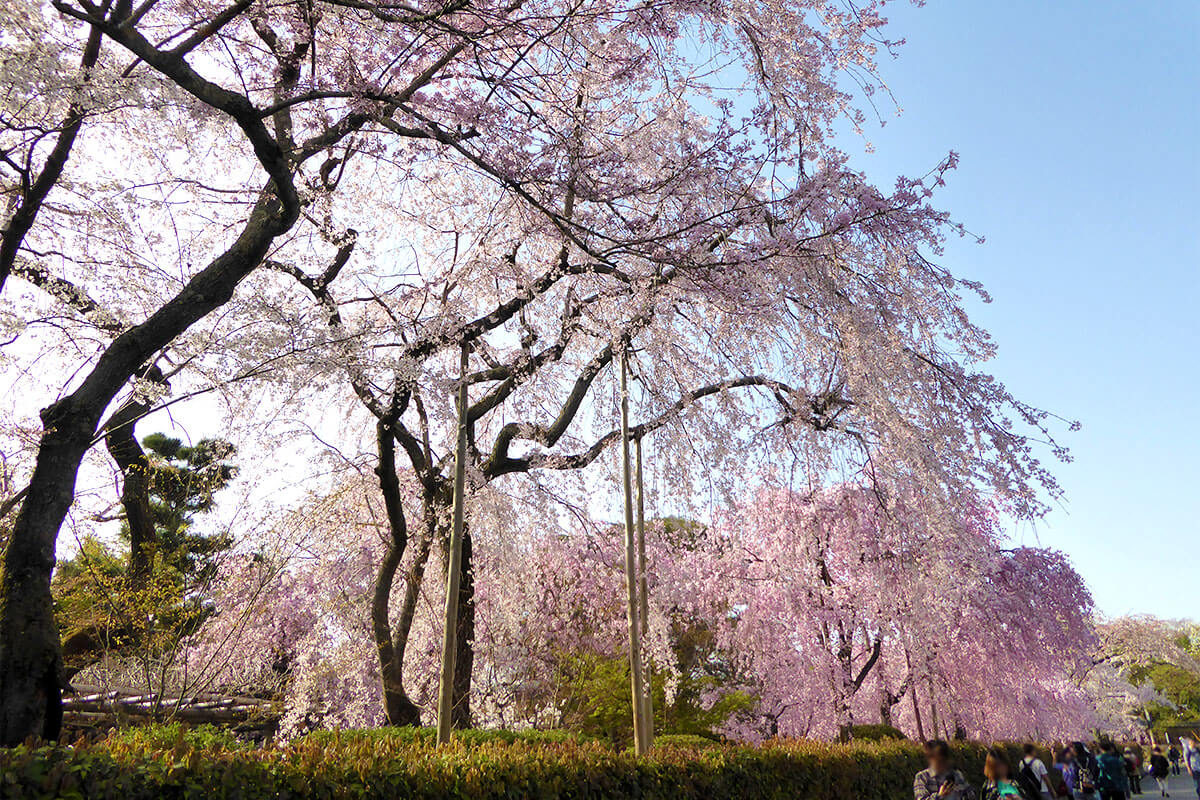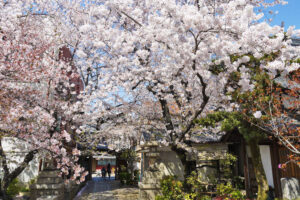
Okazaki Sosui is one of the famous cherry blossom viewing spots in Kyoto. Along the sosui, rows of Someiyoshino cherry trees continue to grow. The view of petals falling from the clusters of flowers in full bloom onto the surface of the water is magnificent.
Now, a "Jyuseki-Bune" (a boat with a capacity of ten stone) is operated on the Sosui for sightseeing from the end of March until Golden Week, and it is a typical springtime event in Okazaki. The area surrounding the Sosui is a sightseeing and cultural area with Heian Shrine, museums, a library, a zoo, etc. If you follow the Sosui toward Nanzenji Temple, you will find a villa area.

Cherry blossoms in the villa area in the Nanzenji neighborhood (*Last year's view)
But,Kan Kikuchi, a great writer and founder of Bungeishunju-sha, described in his novel Okazaki Sosui in a completely different form than the tourist attraction it is today.It is a short story titled "The Throwing Rescue Business. If it had been published in the present age, there might have been complaints from many places in Kyoto. Because, he boldly wrote, "Sosui is a quite good place for suicide, although it is only about 10 ken wide. (Excerpt from the original).
To briefly introduce the story, the main character is an old woman who runs a tea store by a sparse stream. Whenever she finds people who have thrown themselves into the water, she saves their lives by offering her rod into the water and receives a reward for her work. One day, however, misfortune strikes the old woman. The old woman, in despair, throws herself into the water and is saved.
Just,The Sosui depicted in the novel is beautiful.The water is clear and willows are planted on both banks. At night, the blue gas light smokes, and on rainy nights, the blue and red lights on both banks are reflected on the water. Such is the nature of the area.He said that the view of the dugout at night causes romance and makes death seem less terrifying.
I have not heard that people actually jumped into the Sosui at that time, but when I read the story, I remembered that there is an anecdote similar to this one at Chidorigafuchi in Arashiyama, a place where people used to throw themselves into the Sosui. As I introduced in this blog before, I heard that there were many people who threw themselves into the pool, either because they were fascinated by the beautiful scenery or because they thought that the beautiful scenery in this world was connected to the paradise in the other world.Beauty, they say, fascinates even demons, but are those who are taken in by demons also fascinated and drawn in?
[related-article field="related1″].
The Okazaki Sosui, which captured the imagination of the artist, was one of the three major urban redevelopment projects of Kyoto City during the Meiji and Taisho eras, and was promoted as the "Second Lake Biwa Sosui Excavation.Waterway from Lake Biwa through the mountains to Kyoto CityThis grand project calledAfter the Meiji era, the center of Japan completely shifted to Tokyo, and the city of Kyoto, which was on the verge of desolation, was revitalized.I ask.
And the following folk tale remains about this Lake Biwa Sosui project.
At that time, it was decided to run water from Lake Biwa to the city of Kyoto,Many people in Kyoto, Shiga, and Osaka opposeIt was. People in Kyoto said that when the water from Lake Biwa entered the Kamo River, the quality of the water changed, and when they used the water, their skin turned as black as that of Lake Biwa's famous Gengoro-buna (beech). The people of Osaka, downstream of the Yodo River, were worried that the Yodo River's water would increase and cause flooding every time heavy rain fell. It is also said that the world was astonished that the project was completed using only Japanese technology, and that the Russians opposed war with Japan, saying, "Never underestimate Japan.

Postcards of Sosui from Meiji to Taisho Periods (in the author's collection)

Monument of Biwako Sosui.
The man who opens the sluice gate and the sparkling water of life
Okazaki Sosui, which has been told in novels and folk tales, is now a popular tourist attraction for Kyoto citizens and tourists. Especially in March and early April, cherry blossoms frame both banks of the river, which are lit up at night as a cherry blossom corridor, casting a light red shadow on the surface of the water and showing us a glimpse of an ethereal world. One wonders what kind of novels would have been written if Hiroshi Kikuchi had seen the Cherry Blossom Corridor in full bloom instead of the willows and gas lamps.

Cherry blossoms in Okazaki Sosui (*Last year's view)

Hanami was already established in the early Edo period!

Not only to be loved, but also to be significant in history?

From classic hanami spots to hole-in-the-wall

Take your time and enjoy the delicious food to the fullest.
Tradition that exists everywhere in the city of Kyoto. It is not just a picture, it is secretly alive in this modern age and continues to coexist with people. The two of Office TO, who previously wrote a series of articles "Kyoto's Demon World Exploration" in the monthly magazine Leaf, explore the mysterious "different" world of Kyoto, which was created over 1200 years. I will unravel the story while actually visiting the place. .
 News
News Feature article
Feature article Featured event
Featured event